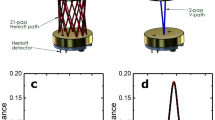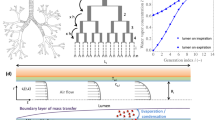Abstract
IN 1953 a gas in an aqueous solution, injected intravenously was used for the first time in studying the functioning of the lungs1. It was later shown that all acetylene so injected was eliminated rapidly through the lungs. About 40 per cent was eliminated in the first minute by a healthy person. If the concentration of acetylene in the expired air was registered continuously by means of a special infra-red spectro-photometric method a direct determination of the interval between the commencement of the injection and the initial appearance of acetylene in the expired air could be made. This is probably the most accurate method for measuring the time of circulation from the site of the injection to the lungs. The acetylene elimination capacity was specially low in the presence of extensive pulmonary fibrosis; elimination of the gas was also retarded during an asthmatic attack.
This is a preview of subscription content, access via your institution
Access options
Subscribe to this journal
Receive 51 print issues and online access
$199.00 per year
only $3.90 per issue
Buy this article
- Purchase on Springer Link
- Instant access to full article PDF
Prices may be subject to local taxes which are calculated during checkout
Similar content being viewed by others
References
Colldahl, H., Acta allergologica, Suppl. III, 61 (1953).
Colldahl, H., Third Europ. Congr. of allergy, Firenze 1956 (II Pensiero Scientifico, Roma).
Author information
Authors and Affiliations
Rights and permissions
About this article
Cite this article
COLLDAHL, H., ALVÄGER, T. & UHLER, J. A New Method for Studying the Functioning of the Lungs. Nature 184, 372–373 (1959). https://doi.org/10.1038/184372a0
Issue Date:
DOI: https://doi.org/10.1038/184372a0
Comments
By submitting a comment you agree to abide by our Terms and Community Guidelines. If you find something abusive or that does not comply with our terms or guidelines please flag it as inappropriate.



